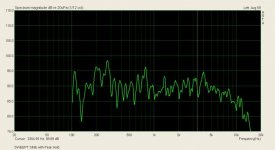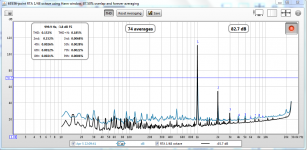Impulse response measurement with swept sine is much better way to measure, be it gear, speakers, or room interaction.
Generic measurement microphones are typically very flat from 50Hz-4kHz, some up to about 7kHz. High quality measurement microphones are often flat from below 10Hz to >20kHz.
.
Hi Barelywater,
I found a swept sine wav file at audiocheck.net. Here is my measurement with peak holding.
Without signal in silent room below 2Khz the curve is klimbing from 15 DB up and down ! But flat above 2 khz within 2 db with smoothing on.
is the + 2 or 3 db at 4khz can give a brighty treble or peak energy in treble ?
Why below 2 khz without sound the curve is not flater ? Hope to be in topic.
Pink Noise give a diferent result with peaks at 3300, 4500, 6 to 7000 hz
Attachments
Last edited:
Hi Eldam,I'm away from home right now,couldn't continue.I will start over by this weekend.Hi Jayadev,
did you suceed having a flater response in your room (without sound) ?
I don't see a problem here. This s/w is measuring the level in fractional octave bands, so if your residual soundcard noise is essentially 'white', then you would expect the plot of the noise to rise at 3dB per octave. At a first glance, this appears to be what you get.
This is the reason why you use a pink noise signal for fractional-octave RTA measurements. (Pink noise rolls off at -3dB per octave, so produces a flat response curve when measured by an RTA). If your plot was measuring the noise in bands of equal Hertz (perhaps in 1kHz wide bands) then you would see a flat measurement result if the noise is white.
This is the reason why you use a pink noise signal for fractional-octave RTA measurements. (Pink noise rolls off at -3dB per octave, so produces a flat response curve when measured by an RTA). If your plot was measuring the noise in bands of equal Hertz (perhaps in 1kHz wide bands) then you would see a flat measurement result if the noise is white.
OUROBOROS, thank you for your input...
Don't want to high jack the post of Jayadev. Sorry for my low knowledge, but does it mean that I don't have to be frighten by big variation of the curve in a silent room when my mic and RTA are switched on ?
Because the low end of the mic+room are always enough flat (I have peak of more 10 or 15 db below 1,5 khz in silent room) for sweep sine or pink noise injected ?
Is it another way to say that with pink noise injected with a good enough micro (here ECM8000), I will see only the trouble of room+speaker in bass area and not the relation between mic+soundcard+phantom powersupply added to the measurement of the speaker ?
Don't want to high jack the post of Jayadev. Sorry for my low knowledge, but does it mean that I don't have to be frighten by big variation of the curve in a silent room when my mic and RTA are switched on ?
Because the low end of the mic+room are always enough flat (I have peak of more 10 or 15 db below 1,5 khz in silent room) for sweep sine or pink noise injected ?
Is it another way to say that with pink noise injected with a good enough micro (here ECM8000), I will see only the trouble of room+speaker in bass area and not the relation between mic+soundcard+phantom powersupply added to the measurement of the speaker ?
Last edited:
Given a muted input, the absolute noise floor is below -100dB, slope being irrelevant at such low levels. This is a 'good' result. If you have -80dB noise floor with mic turned on and gain set correctly (0dB input to output, 60dB at mic producing 60dB at loudspeaker) that would be classified as 'Excellent'. It is practically impossible to have actual noise floor below -60dB in most urban settings. I don't know where you live, but most cities in India are frightfully noisy at all times of the day. In a very quiet, untreated room in the middle of the night, I get about -50dB when the microphone is set to 'medium' sensitivity. Real noise floor is closer to -40, treatment can improve this handily but I haven't got around to doing it.
The USB Creative soundcards have a peculiar problem that you will encounter when actually using for measurement, seek out the Asawari build thread to find it. You will never get the response aligned correctly because of the variable latency over USB using the Creative drivers.
You can surmount this by using a low-latency solution - either a PCI/PCI/Express soundcard (and not creative, something with decent drivers) or a good USB solution that offers ASIO drivers. You will still have round trip latency of 10mS or so, but you can adjust that in RMAA because it's more or less fixed.
The USB Creative soundcards have a peculiar problem that you will encounter when actually using for measurement, seek out the Asawari build thread to find it. You will never get the response aligned correctly because of the variable latency over USB using the Creative drivers.
You can surmount this by using a low-latency solution - either a PCI/PCI/Express soundcard (and not creative, something with decent drivers) or a good USB solution that offers ASIO drivers. You will still have round trip latency of 10mS or so, but you can adjust that in RMAA because it's more or less fixed.
Very helpfull, thank you.
At night it depends in france, where you live and the moment of the night and if you are in a modern construction (Three or two layers of windows).
After 2 am , i have a relative quiet room, and can find ten second for inject a sweep sine.
I will have a particular look to the DB column.
My Creative pre usb use ASIO drivers...
At night it depends in france, where you live and the moment of the night and if you are in a modern construction (Three or two layers of windows).
After 2 am , i have a relative quiet room, and can find ten second for inject a sweep sine.
I will have a particular look to the DB column.
My Creative pre usb use ASIO drivers...
Last edited:
Agree, I didn't use mic based RTA so far, rather I recently started using android phone based RTA apps.In a very quiet, untreated room in the middle of the night, I get about -50dB when the microphone is set to 'medium' sensitivity. Real noise floor is closer to -40, treatment can improve this handily but I haven't got around to doing it.
One easier app I am mostly using is -RTA Audio Analyzer
It reads around -50db when nothing is playing in my room. The curve with default setting is also not flat. Here the noise of computer, inverter etc are also accounted. I chose standard calibration before measuring the audio output. Standard calibration brings the most of low, mid and high frequencies at level except few raised bars here and there.
When I try to measure pinknoise, I let the volume raise until it reaches upto till -20db peak approx. Then I try to make the curve of pinknoise output flat using param EQ in JRiver. The sound changes drastically. Am I doing it right?
Last edited:
The RTA AA Android app uses your phone microphone for input. This mic (yes, it is a mic!!) has no response below 200Hz and above 4KHz. It has an extremely small diaphragm so proximity effect is massive. A few centimeters of position change affects the frequency response drastically, you can experience this when you move away from the phone. The midband is boosted artificially in all of these handsets, to increase vocal clarity.
Now, when you play a totally flat speaker in a totally flat anechoic chamber and measure it with RTA on Android, you will not get a flat line. You know why? Because the microphone is not flat.
Next, to the noise impulse. Pink noise has decreasing energy of 3dB per octave. Which means that the 20KHz signal is -30dB from the level of the 20Hz signal. When you try to flatten the frequency response using pink noise as a base, your system will be 30dB hotter at 20KHz than it is supposed to be. You will end up with a very shrill and strident system.
Then, the room has its own issues with reflections and room modes. You cannot discount these, and they get worse with prolonged excitation so everyone worth their salt uses impulse mode. Audyssey is an example of a consumer product that uses swept tones, that and burst mode is the only way to somewhat measure first arrival in consumer rooms. I use it quite often when I'm calibrating speakers - my receiver only has seven bands, but even that is enough to give me an idea of what I need to do to fix the response. All other issues must be acoustically treated first before applying EQ.
Finally, you are using a media player equaliser to correct the frequency response. Equalisers reduce bit resolution drastically, meaning the output is now even more compromised. If you must correct electronically, use convolution plugins available in Foobar2000 or a hardware unit like a DBx crossover/MiniDSP, or you could leave the top end untouched and modify your bass response - most problems in the room happen at the low end, not higher. It is much harder to hear the effects of lowered resolution at the bass end, whereas any corrections in midband and treble are almost immediately noticeable.
I cannot think of one thing in your procedure that is being done correctly, sorry for that. Before you despair, consider that only once you hear something that is properly flat, will you get a general idea of the direction you need to head.
And don't worry. Most commercial manufacturers are also legging it - once you hear a few dozen speakers you will realise that the definition of good sound depends on who is defining it. I may have heard about a hundred and many more members here would have heard a thousand or more - and no two sound like each other, not if you listen carefully. After a hundred years or so of existence dynamic drivers are very good, and so are microphones, but neither are properly truthful. The best speakers end up being the ones with the least compromises, not the ones with the highest virtues.
The two things you need to do are one, get a proper measuring microphone. Bajaao stocks the Dayton model, you should be able to find the Behringer locally. Both need a mic preamp or Audiobuddy type interface with phantom power, so that increases the cost. But still, it will be a massive improvement. Two, invest in a good soundcard. It will pay you back many times over its life. Not USB, something internal. For measurement applications, latency is everything.
Now, when you play a totally flat speaker in a totally flat anechoic chamber and measure it with RTA on Android, you will not get a flat line. You know why? Because the microphone is not flat.
Next, to the noise impulse. Pink noise has decreasing energy of 3dB per octave. Which means that the 20KHz signal is -30dB from the level of the 20Hz signal. When you try to flatten the frequency response using pink noise as a base, your system will be 30dB hotter at 20KHz than it is supposed to be. You will end up with a very shrill and strident system.
Then, the room has its own issues with reflections and room modes. You cannot discount these, and they get worse with prolonged excitation so everyone worth their salt uses impulse mode. Audyssey is an example of a consumer product that uses swept tones, that and burst mode is the only way to somewhat measure first arrival in consumer rooms. I use it quite often when I'm calibrating speakers - my receiver only has seven bands, but even that is enough to give me an idea of what I need to do to fix the response. All other issues must be acoustically treated first before applying EQ.
Finally, you are using a media player equaliser to correct the frequency response. Equalisers reduce bit resolution drastically, meaning the output is now even more compromised. If you must correct electronically, use convolution plugins available in Foobar2000 or a hardware unit like a DBx crossover/MiniDSP, or you could leave the top end untouched and modify your bass response - most problems in the room happen at the low end, not higher. It is much harder to hear the effects of lowered resolution at the bass end, whereas any corrections in midband and treble are almost immediately noticeable.
I cannot think of one thing in your procedure that is being done correctly, sorry for that. Before you despair, consider that only once you hear something that is properly flat, will you get a general idea of the direction you need to head.
And don't worry. Most commercial manufacturers are also legging it - once you hear a few dozen speakers you will realise that the definition of good sound depends on who is defining it. I may have heard about a hundred and many more members here would have heard a thousand or more - and no two sound like each other, not if you listen carefully. After a hundred years or so of existence dynamic drivers are very good, and so are microphones, but neither are properly truthful. The best speakers end up being the ones with the least compromises, not the ones with the highest virtues.
The two things you need to do are one, get a proper measuring microphone. Bajaao stocks the Dayton model, you should be able to find the Behringer locally. Both need a mic preamp or Audiobuddy type interface with phantom power, so that increases the cost. But still, it will be a massive improvement. Two, invest in a good soundcard. It will pay you back many times over its life. Not USB, something internal. For measurement applications, latency is everything.
Last edited:
Thanks Snagram, that is very very helpful. 
Earlier I was just confused about which mic to get and was thinking to post a query here but you already posted some options. Isn't there anything which can directly be used without any additional amp?
I was planning to upgrade the soundcard also but was confused about getting external or internal, that confusion is also sorted out now. Thinking about Xonar D2X.
Sorry Jaydev for bit of thread hijacking here
Earlier I was just confused about which mic to get and was thinking to post a query here but you already posted some options. Isn't there anything which can directly be used without any additional amp?
I was planning to upgrade the soundcard also but was confused about getting external or internal, that confusion is also sorted out now. Thinking about Xonar D2X.
Sorry Jaydev for bit of thread hijacking here
Last edited:
Hi Jack,
Used such rta android 2 years ago... The problem is the mic of your phone, poor and different in each phone ! better if used with external amplified mic ! But still poor in relation to A mic amp and calibrated mic... haven't the calibrated but a flater enough mic (ECM8000) to understand the big problem in my room with speajers.
Used such rta android 2 years ago... The problem is the mic of your phone, poor and different in each phone ! better if used with external amplified mic ! But still poor in relation to A mic amp and calibrated mic... haven't the calibrated but a flater enough mic (ECM8000) to understand the big problem in my room with speajers.
Measurement Microphones in the Speaker Components Department at Parts Express | 2057
imm6 is what you are looking for.
imm6 is what you are looking for.
calibrated mic
imm6 is a pretty thing... i can imagine the scene in the train or in my car to measure the noise !
Always asking myself for the Dayton clone ECM-8000 if the calib file is a generic or a middle value maid with one mic took in a serie of thounsand in the factory ? Seems to cheap for an individuel measurement ?
Spectrum are better (a little more expensive) and individually calibrated ?
imm6 is a pretty thing... i can imagine the scene in the train or in my car to measure the noise !
Always asking myself for the Dayton clone ECM-8000 if the calib file is a generic or a middle value maid with one mic took in a serie of thounsand in the factory ? Seems to cheap for an individuel measurement ?
Spectrum are better (a little more expensive) and individually calibrated ?
Yes, analysers are all-in one so each instrument is calibrated to its individual readout.
Don't worry about using generic measurement microphones unless you are sure your room is flat to +-5dB and have a smooth waterfall at 200ms or taller. Chances are the mic will be flatter than your room anyway. At the top end it is possible to make a room somewhat flat, but below 500Hz forget it.
Don't worry about using generic measurement microphones unless you are sure your room is flat to +-5dB and have a smooth waterfall at 200ms or taller. Chances are the mic will be flatter than your room anyway. At the top end it is possible to make a room somewhat flat, but below 500Hz forget it.
@Sangram - I contacted the website you mentioned for imm6 and found that I will have to handle the customs, duties and other hassles after the mic reaches to India. So overall it will turn out much expensive purchase I think. After knowing about it, I am prefering such mic since it will be a mobile RTA in pocket and I can even calibrate my car audio. Isn't there any Indian seller? I tried ot find but couldn't find any.
BTW I tried to do more experiments with existing phone mic and measured the woofer and tweeters separately:
Default reading when app is loaded in the room without playing any sound, only PC was on:
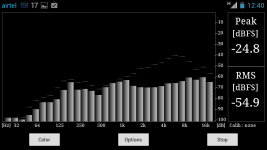
Reading of the room after loading standard calibration:
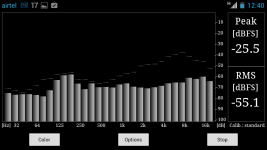
Reading of pinknoise on the tweeter:
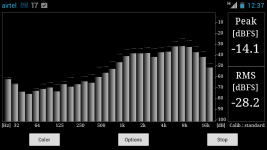
Reading of pinknoise on the woofer:
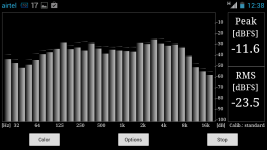
Is it fully inaccurate or is it giving atleast little bit of idea?
This is what gsmarean says about Moto Atrix mic which I have :
![gsmarena_a001[1].png gsmarena_a001[1].png](https://www.diyaudio.com/community/data/attachments/355/355008-271bba4f07b3e76a3f061af14aef93e8.jpg)
Motorola Atrix 4G review: Enter the Atrix - GSMArena.com
BTW I tried to do more experiments with existing phone mic and measured the woofer and tweeters separately:
Default reading when app is loaded in the room without playing any sound, only PC was on:

Reading of the room after loading standard calibration:

Reading of pinknoise on the tweeter:

Reading of pinknoise on the woofer:

Is it fully inaccurate or is it giving atleast little bit of idea?
This is what gsmarean says about Moto Atrix mic which I have :
![gsmarena_a001[1].png gsmarena_a001[1].png](https://www.diyaudio.com/community/data/attachments/355/355008-271bba4f07b3e76a3f061af14aef93e8.jpg)
Motorola Atrix 4G review: Enter the Atrix - GSMArena.com
Last edited:
That graph is for headphone output, not microphone input. GSMA does not measure mic response.
No Indian seller has even heard of this kind of category or usage, let alone stock this. You can do a group buy, or place a larger order with some more stuff to reduce the shipping cost. The package is delivered to your door and UPS collects the customs duty from you.
No Indian seller has even heard of this kind of category or usage, let alone stock this. You can do a group buy, or place a larger order with some more stuff to reduce the shipping cost. The package is delivered to your door and UPS collects the customs duty from you.
imm6 is what you are looking for.
Finally got the IMM-6, very tinny in the size than I expected, easy to carry anywhere.imm6 is a pretty thing... i can imagine the scene in the train or in my car to measure the noise !
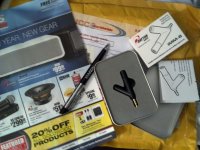
Now I need some help which app is best to use? I got RTA Analyzer demo and AudioTools full versiosn.
I want to use this mic to calibrate my audio setup to make it sound flat. Initial measurements using AudioTools suggest heavy peaks and drops at various frequencies my audio setup.
Tried to see the effect by adjusting soundcard's EQ at first stage but the peaks and drops are beyond the limit of EQ. My doubt is on the speakers and crossovers points since soundcard and AMP are pretty decent.
Sound Card : Asus Xonar D2X
AMP : LM3886 DIY
Speakers : 3 way unbranded.
Last edited:
D
Deleted member 148505
What good but cheap USB sound card you guys recommend?
I bought a generic usb soundcard because my current laptop (lenovo x230) doesn't have a mic input.
The usb soundcard I bought gives horrible measurement. In the attached picture, the blue plot corresponds to the loopback in/out, while the black plot is from an iphone 5 source.
I borrowed my sister's macbook pro and I got good thd+n levels (< 0.001%) with its built in mic input, but I don't want to use it for my amplifier measurements.
I also tried my cheap generic usb card on the mac book pro, and of course, the result is almost the same on the attached picture.
I bought a generic usb soundcard because my current laptop (lenovo x230) doesn't have a mic input.
The usb soundcard I bought gives horrible measurement. In the attached picture, the blue plot corresponds to the loopback in/out, while the black plot is from an iphone 5 source.
I borrowed my sister's macbook pro and I got good thd+n levels (< 0.001%) with its built in mic input, but I don't want to use it for my amplifier measurements.
I also tried my cheap generic usb card on the mac book pro, and of course, the result is almost the same on the attached picture.
Attachments
Last edited by a moderator:
- Status
- This old topic is closed. If you want to reopen this topic, contact a moderator using the "Report Post" button.
- Home
- Source & Line
- PC Based
- RTA measurements and soundcard
